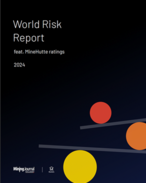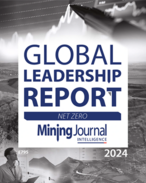Long-time gold bull and investment guru James Rickards has previously predicted gold prices upwards of US$27,000 per ounce in the not-too-distant future. He maintained that this guess was not to "get attention or shock people" but was rather a result of "rigorous analysis".
Speaking to MNN's Chris Cann on the sidelines of Rick Rule's Rule Symposium in Boca Raton, Florida, this week, Rickards maintained his view on the enduring value of gold and outlined the key role global central banks play the metal's ‘safe haven' status.
Investors in the mining space often consider gold a safe haven because it's generally known that in times of economic turmoil, gold's value rises. But the same is true for geopolitical and military turmoil, and one needs to look no further than the Russia-Ukraine conflict to see this.
Treasures over treasuries
At the start of Moscow's invasion of Ukraine in 2022, the United States and its allies blocked transactions with Russia's central bank and finance ministry, effectively freezing some $300 billion over sovereign Russian assets held in the West.
Like most central banks, Russia had diversified its wealth by placing some of its gold and foreign exchange reserves in liquid assets like government bonds and major currencies, with around half of those reserves held in various Western countries.
So, when the US and its allies blocked central bank transactions, those assets were effectively stranded outside Russian borders.
In the years since then, Western central banks have been working out ways to seize those frozen assets and redistribute them to Ukraine to aid the smaller country's war efforts.
The US was leading the charge to seize the assets at this year's June G7 meeting in Italy, Rickards explained.
"They say seize; I say steal," Rickards said.
"Frozen is one thing. We froze Iran's assets — they got them back in the long run by-and-large. But this is stealing Russian assets."
The fact that all transactions are now digital makes such asset freezing and seizing just a few keystrokes away.
Unless, of course, a central bank's wealth is stockpiled in a high-security vault.
"If you own physical gold and you have it in a vault in your country, there's nothing the United States can do," Rickards said.
"You can't intercept it, you can't freeze it, you can't seize it … you can't do anything."
The West's asset freezing and attempted seizing has reinforced this idea — not least of all for other central banks that may consider themselves geopolitical opponents to the US.
The precedent set by the West's response to Russia's invasion has prompted other nations to scrutinise where they place their wealth.
"People around the world are saying, ‘Oh, well, today you don't like Russia. You're stealing their treasuries. What if tomorrow you don't like me?'," Rickards said.
"Saudi Arabia, Taiwan, South Korea, Japan, China … certainly, all these countries have hundreds of billions — upwards of a trillion dollars, in the case of China — of US treasury securities. They're all a mess."
The three biggest bond markets in the world other than the US are Germany, Italy and Japan — all vassals of the States, Rickards said. Eastern countries are unlikely to divert to these bond markets of the US'.
"So, where can you go? The answer is gold.
"You don't have to be a gold lover; you just sort of end up there by default."
The irony in this scenario is that the increased buying of gold drives up the price, and the increased price increases a country's wealth. The West's efforts to dampen Russia's wealth have had the opposite effect.
"While the US is busy trying to steal US Treasuries, Russia's reserve position has increased by $50 billion as gold went from $1700/oz to $2400/oz."
Already a strong market
All this comes against a backdrop of some already-strong buying from central banks over the past decade and a half.
Between 2010 and now, Japan has purchased 300t of gold, Rickards said. Russia has upped its reserved from 600t to 3000t. China, which also had circa 600t in 2010, claims it now has just under 3000t, but Rickards claimed it was reasonable to assume Beijing had two to three times that amount off the books.
The US hasn't bought any.
Rickards said tech hype and a complacency around the US dollar was overshadowing gold's value-driving potential, making it difficult to get US consumers excited about gold.
Nevertheless, the yellow metal's safety is becoming more apparent than ever to big geopolitical players, and prices are rising to reflect this.
Rickards' price predictions were already far above conventional analyst expectations when he suggested the metal would rise to $15,000/oz by 2026 — before he upped his prediction earlier this year to $27,000/oz.
As with all things commodities, time will tell if Rickards is on the money.


























